This Lemon Olive Oil Cake recipe is the perfect easy elegant dessert that stays moist for days and is loaded with lemony flavor. This cake is so good it can be served simply on its own or can be dressed up with whipped cream and berries for an easy and elegant dessert.
Table of contents
What is an Olive Oil Cake (Ciambellone)
Olive oil cakes use olive oil as the main fat instead of vegetable oil or butter. One of the best characteristics of olive oil cake is that they stay moist for days. Plus, the olive oil adds a fruity, slightly spiced flavor to cake. Olive oil cakes are an important part of olive harvest celebrations in the Mediterranean.
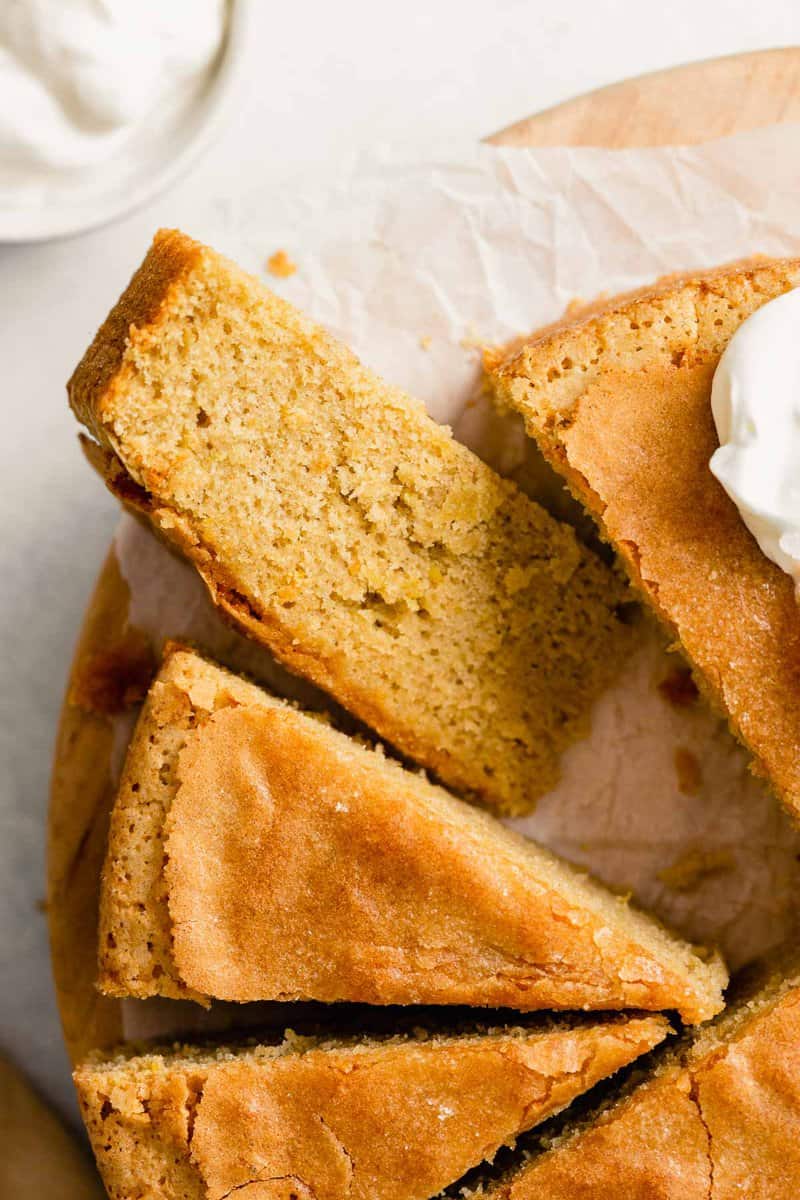
Why Bake with Olive Oil
Baking with olive oil creates an incredibly moist cake. Because oil is 100% fat (butter is 80% fat), it adds fat without adding water, which aids in creating a moist cake that stays moist for days.
Does This Cake Taste Like Olive Oil?
This is all dependent upon which type of olive oil you choose to use.
- For a mildly-flavored cake: use “light” olive oil
- For a slight note of olive oil: use regular olive oil or “light” extra-virgin olive oil
- For a strong-flavored cake: use regular extra-virgin olive oil or extra-virgin olive oil labeled as “robust”
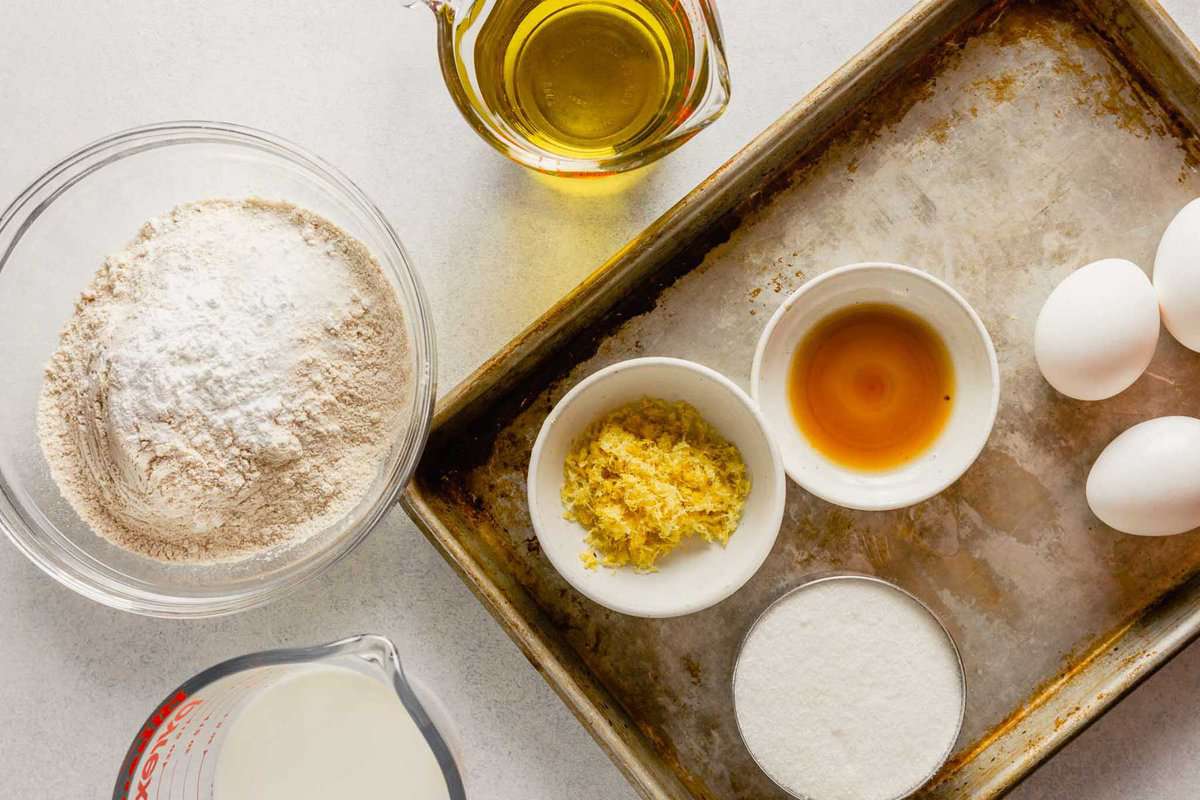
Recipe Ingredients
- White whole-wheat flour: we like to bake with whole-wheat flour around here. Aside from the nutritional benefits, whole-wheat flour develops gluten at a much slower rate than all-purpose flour. Why does that matter? For starters, it decreases the risk of over-mixing the batter drastically. And secondly, it makes for a very light and tender cake crumb.
- Baking powder: important for adding lift to this moist cake.
- Salt
- Large eggs: it’s important to use eggs labeled as “large” not medium, not Jumbo, you need large eggs. A large egg, out of shell, should weight about 50 grams. Using the correct size of egg is important for achieving the correct texture. If too small of an egg is used, there won’t be enough moisture and fat. Too large and too much moisture will be added.
- Sugar: granulated sugar is used in the cake and on top to create a lovely, crunchy crust.
- Lemon zest: use a microplane to finely grate the lemon zest. You’ll need two packed tablespoons of lemon zest, so make sure you have 4–5 lemons for this.
- Vanilla extract: for the best flavor, use pure vanilla extract. Vanilla bean paste would also be great.
- Olive oil: use whatever olive oil you enjoy the most. If you love the rich and bold flavor of extra-virgin olive oil, use that! And if you don’t want the olive oil to be overly present, use a light or regular olive oil.
- Whole milk: make sure you use whole milk—not low-fat dairy milk. We haven’t tested this, but if you want to make this vegan, use a non-dairy milk such as soy milk or almond milk.
How to Make Lemon Olive Oil Cake
- Start by whipping the eggs in a stand mixer until foamy. Meanwhile, whisk together the dry ingredients.
- Add the sugar, lemon zest and vanilla and whip, on high speed, until thick, gorgeous (!!), fluffy, and pale in color. It should be stunning!!
- Slowly drizzle in the oil.
- Mix in the flour and milk, alternating between the two.
- Pour the batter into a greased springform pan and sprinkle with sugar.
- Bake until the top is deep golden brown.


Do You Have to Use a Springform Pan?
Part of the appeal of this cake is its height. And since we work hard to achieve height—whipping the eggs and sugar—we want to maintain the height while baking. A springform pan, with its tall sides, is the ideal vehicle for baking this cake. It encourages height and ensures no overflow of batter.
Using a springform pan also protects the crusty top—inverting this cake, like you would have to with a normal cake pan, would destroy the top. The ability to simply loosen the sides and lift away is what makes a springform pan so user-friendly for a home baker.
If you know your springform pan isn’t overly nonstick, go ahead and line the bottom of the pan with some parchment paper.
If you’re really adamant about using a regular cake pan, there are some things to keep in mind. First, I would skip the sugary top (or be OK with it cracking and crumbling off when inverting). Second, be sure to place a baking sheet on the rack right below the cake to catch any batter that may overflow. And third, in an attempt to avoid overflow, be sure to use a cake pan with tall sides.
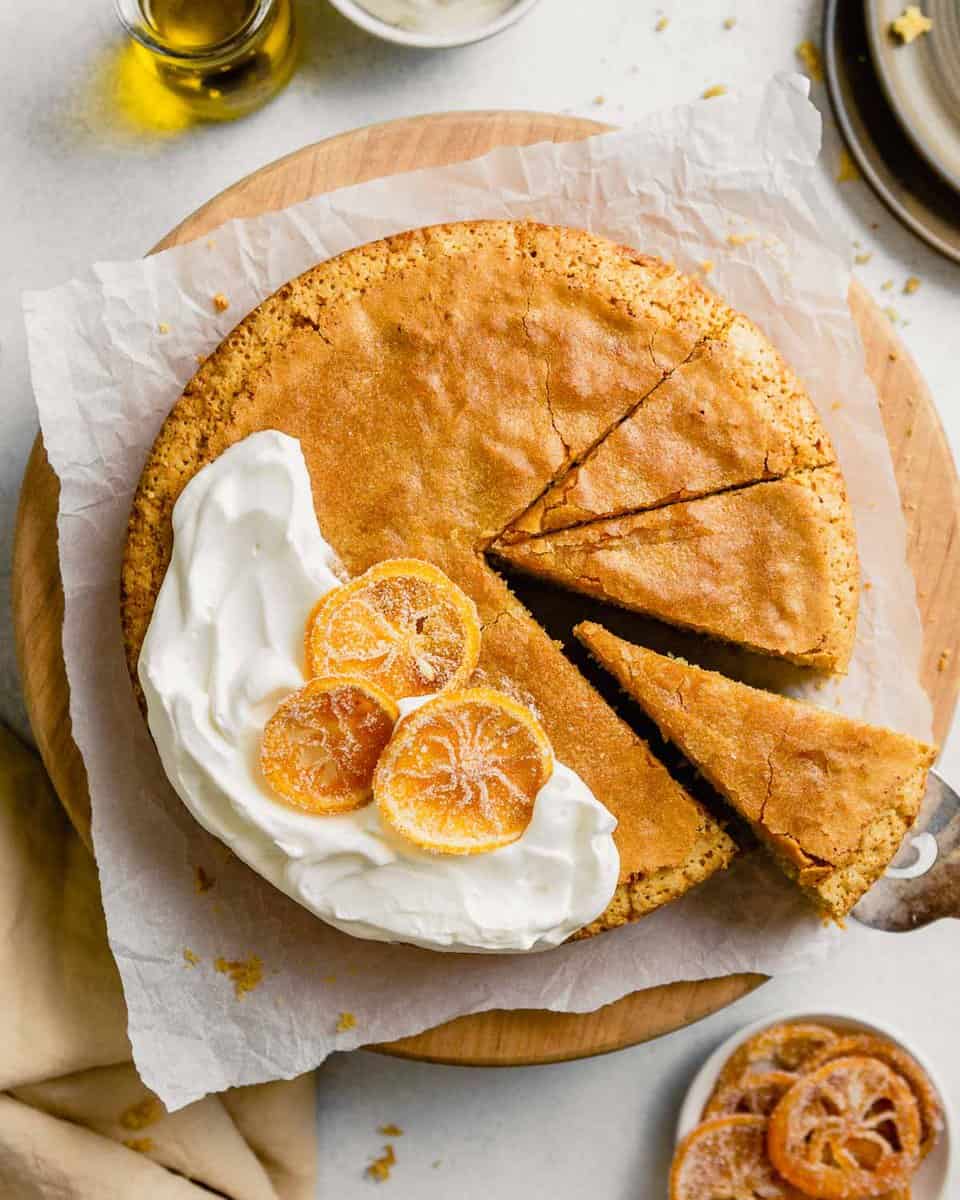
Tips for Making the Best Lemon Olive Oil Cake
Use Good Quality Olive Oil
Other than lemon zest and a splash of vanilla, olive oil cake gets a majority of its flavor from olive oil, which means it’s imperative to use good quality olive oil. More than anything, make sure you’re using extra-virgin olive oil.
Don’t Over-Bake and Don’t Under-Bake
This might seem obvious, but let’s give it a bit of attention. First of all, like anything, bake this cake to your personal preference.
Do you prefer your cakes and quick breads to be more dense and moist? Bake towards the shorter end of the time range given.
Prefer your cakes to be, well, more cake like (tall, sturdy, baked properly)? Bake the cake towards the middle or end of the time range listed.
Avoid baking this cake longer than the range given (unless your toothpick is still coming out covered in batter!), olive oil cakes are known for being deliciously moist and you don’t want to bake that moisture out!
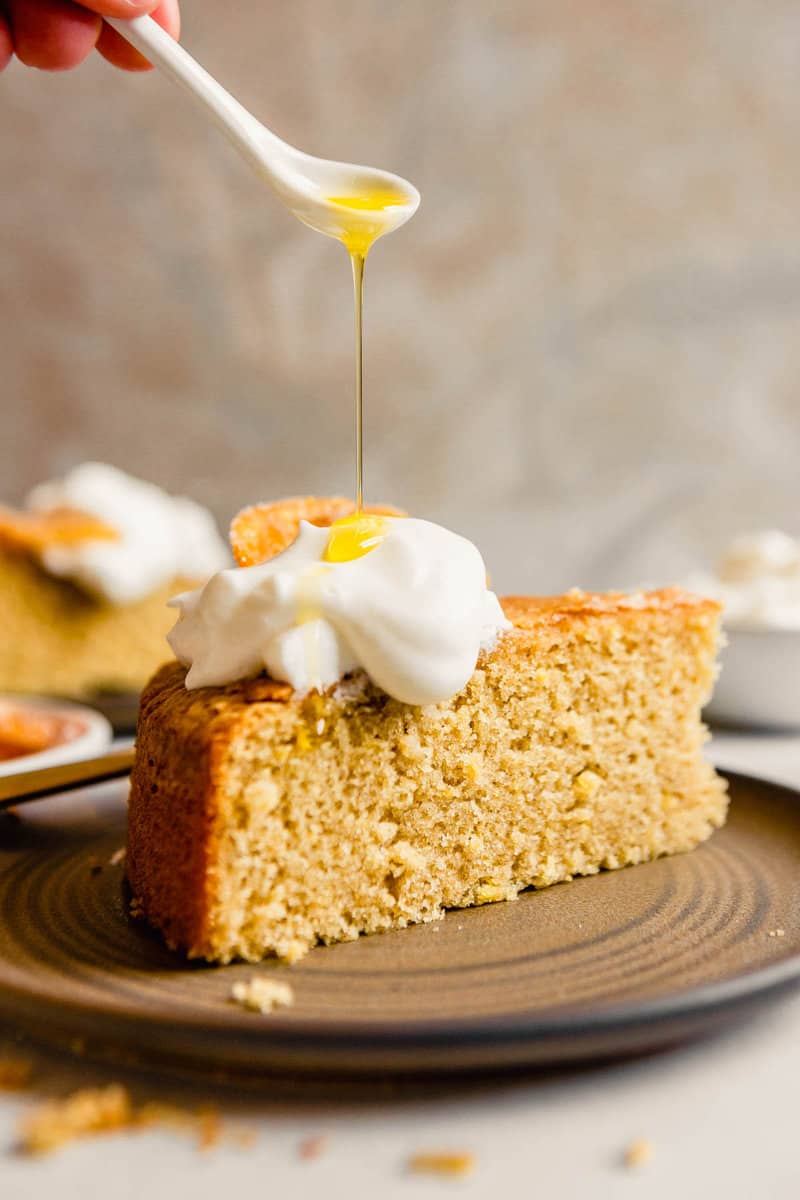
Whip the Eggs
Whipping whole eggs (not just whites) with sugar helps to create an olive oil cake that’s airy and fine textured while still being pretty sturdy. Sturdy is important here since a batter made with olive oil is heavier than one made with whipped butter.
Give it a Crackly, Sugar Topping
Any and all cakes can benefit from a bit of crunchy texture in my opinion. Right before baking, I sprinkle a thin layer of sugar over the batter to create a nice sugary crust once baked. If you don’t want that added bit of sugar try sprinkling sliced almonds over top for a finish that’s both crunchy and stunning.
How to Serve + Toppings
Serve lemon olive oil cake with a cup of coffee or tea for an afternoon snack. Or dress up the cake with whipped cream and fresh fruit for a stunning after-dinner dessert. Here are a few topping ideas:
- Fresh mixed berries
- Whipped cream and a drizzle of olive oil
- Chopped fresh rosemary or thyme
- Lemon curd, orange curd or rhubarb curd
FAQ
You’ll know your cake is not properly baked yet if a toothpick or wooden skewer inserted in the center comes out with batter sticking to it. You’ll know it’s baked properly when the skewer comes out with just a few moist crumbs attached.
There are a few things you can do to avoid a hole or crater forming in the middle of your cake. First, make sure you properly measure everything—especially the baking powder. No eye-balling measurements here!
Secondly, make sure your baking powder is fresh and not past its best-by date.
Third, use an oven thermometer to determine how accurate your oven is. Baking in an oven that’s either too hot or too cold can cause the cake to sink in the middle.
To create a super soft cake, you need to do a few things. First, use a light flour such as cake flour or add a bit of cornstarch to the dry ingredients.
Second, whip the eggs to add air to the batter.
Third, use oil instead of butter to ensure the cake if not only soft, but moist also!
Olive oil is the best oil for olive oil cakes. For more traditional cakes, use a flavorless oil such as vegetable oil or grapeseed oil.
Olive oil and extra-virgin olive oil are the healthiest oils for making cakes.
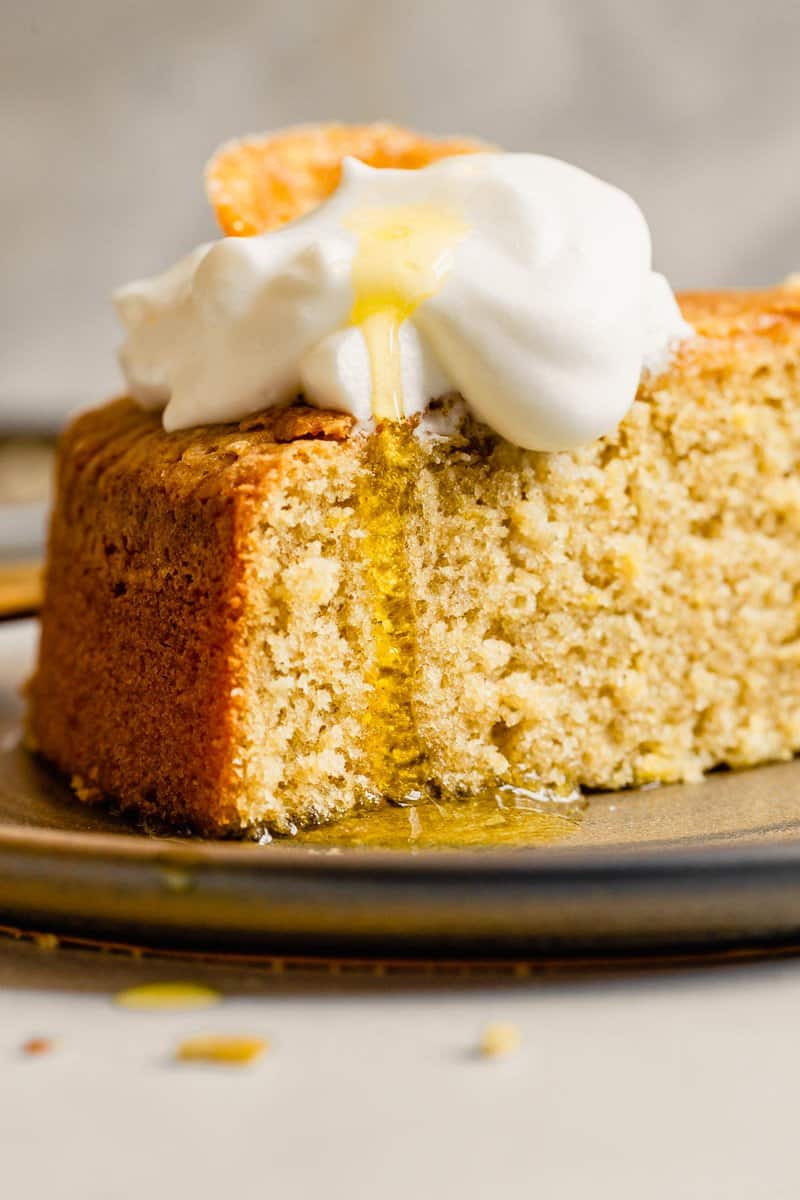
More Lemon Desserts
Our Blueberry-Lemon Curd Tart is a reader-favorite! Stunning and delicious.
If you love lemon curd, then you’ve gotta try our Pistachio Lemon Bars or Classic Lemon Tart.
Our Lemon Poppyseed Zucchini Bread is the perfect summer-time quick bread!
Try our Lemon Blueberry Muffins that are as tall as the sky and beautifully moist and tender.
If you love to make homemade ice cream, then check out our Lemon Poppyseed Ice Cream—it’s out of this world!
This Lemon-Rhubarb Tart is another stunning layered tart recipe to try. Perfect for spring and summer!
Lemon Olive Oil Cake Recipe
Description
Ingredients
- 1 ¾ cups (226g) white whole-wheat flour
- 1 ½ teaspoons baking powder
- 1 teaspoon kosher salt
- 3 large eggs
- 1 cup (200g) sugar + more for top
- 2 tablespoons minced lemon zest
- 1 teaspoon pure vanilla extract or vanilla bean paste
- ¾ cup (160g) extra-virgin olive oil
- ¾ cup (175g) whole milk
Toppings, optional:
- lightly sweetened whipped cream
- Candied lemon slices
- Olive oil for drizzling
Instructions
- Heat oven to 350ºF (176ºC) with rack set in middle position. Grease 9-inch springform pan (if your springform pan is prone to leaking, wrap the base in a piece of foil).
- Whisk together flour, baking powder, and salt in bowl; set aside.
- Using stand mixer fitted with the whisk attachment, whip eggs on medium speed until foamy, about 1 minute. With mixer running, add sugar, lemon zest, and vanilla. Increase speed to high, and whip until mixture is fluffy and pale yellow, about 3 minutes.
- Reduce speed to medium and, with mixer running, slowly stream in oil; mix 1 minute. Reduce speed to low and add half of the flour; mix until incorporated, about 1 minute, scraping down side of bowl as needed. Add milk and mix until combined, about 30 seconds. Add remaining flour mixture and mix just until incorporated, about 1 minute, scraping down side of bowl as needed.
- Transfer batter to prepared pan; evenly sprinkle top with about 2 tablespoons sugar. Bake cake until top is deep golden brown and a toothpick inserted in the center comes out with few crumbs attached, 48–55 minutes.
- Transfer pan to wire rack and let cool for 20 minutes. Loosen and remove side of pan; let cake cool completely, about 1½ hours. Loosen cake from the pan base, transfer to a serving plate, and cut into wedges; serve.
- Optional, top servings with whipped cream, candied lemon wedges, and a drizzle of good-quality olive oil.
Would you like to save this?
Video
Notes
- Up to 1 day: cover cake with foil and store at room temperature.
- 1–3 days: wrap the cake in plastic wrap and store at room temperature .
- Up to 5 days: wrap the cake in plastic wrap and store in the refrigerator.
- Orange: make our Orange Olive Oil Cake! It’s just as citrusy and moist as this recipe with spiced orange segments served on top.
- Triple Citrus: use a combination of lemon, lime and orange zest instead of just lemon zest.
- Citrus & Herb: add some minced fresh rosemary to the batter for a little herby note.
- Almond Olive Oil Cake: use almond extract in place of the vanilla extract and sprinkle sliced almonds over the batter before baking.
- Under-bake by 3 minutes or so if you like it dense and moist. Bake it the full amount of time if you like it more cake-like (still moist!).
- Recipe adapted from America’s Test Kitchen
Nutrition


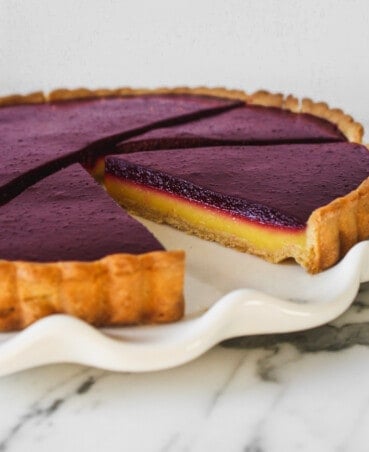

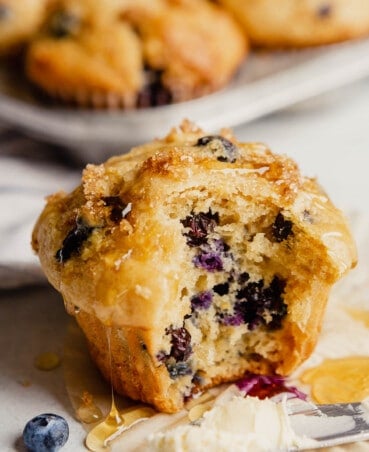

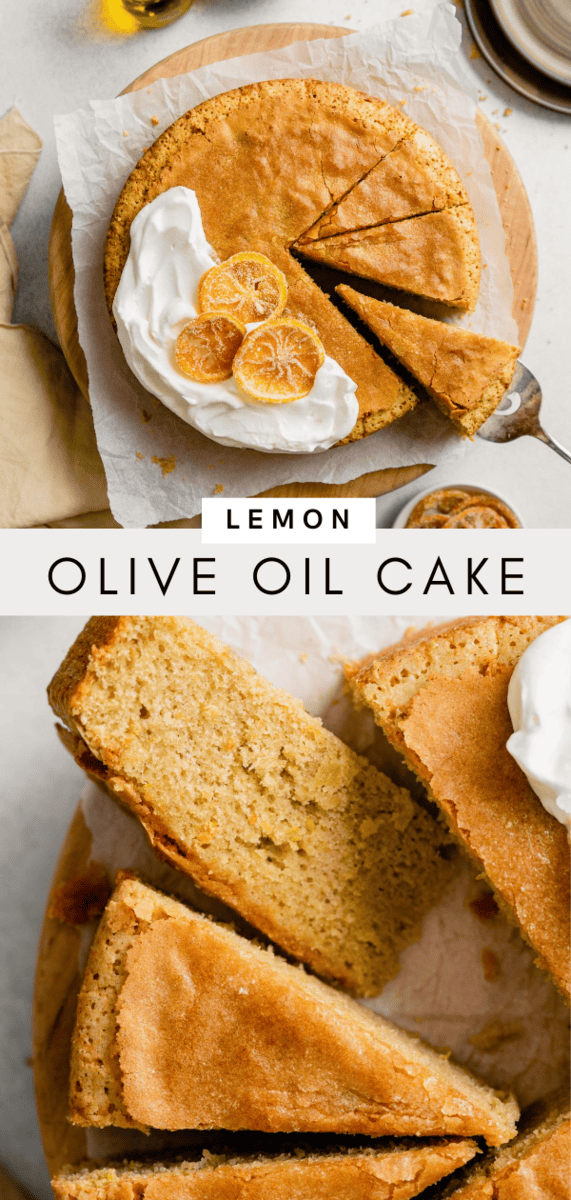
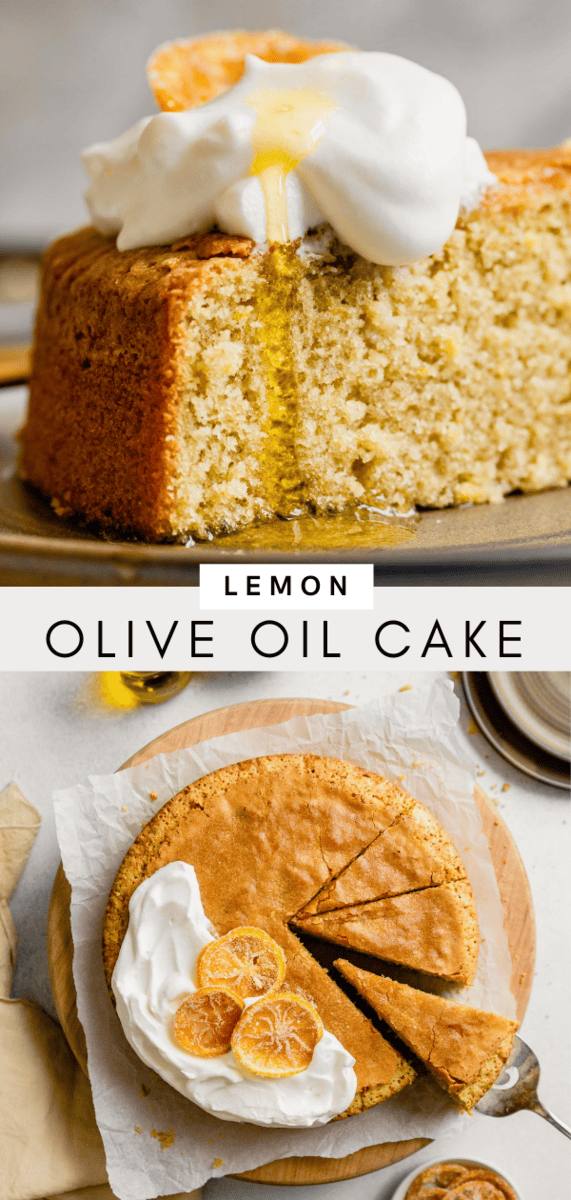
Hi!
Can I use coconut sugar instead of regular sugar?.
Hi Aj! Great question—I haven’t tested this, but here is what I recommend from my experience baking with coconut sugar:
– use 1 1/2 cups coconut sugar to replace 1 cup white sugar.
– grind the coconut sugar into a fine powder using a spice grinder (this is important for texture and even distribution throughout the batter).
– the cake will likely be darker in color and a bit toastier in flavor.
Let me know how it goes!
My sister is dairy free, I’m wondering what you would suggest as a replacement for the whole milk
I would recommend soy milk or refrigerated coconut milk since they both have more fat than other non-dairy milks. I haven’t test this, so I can’t 100% guarantee, but that should work just fine!